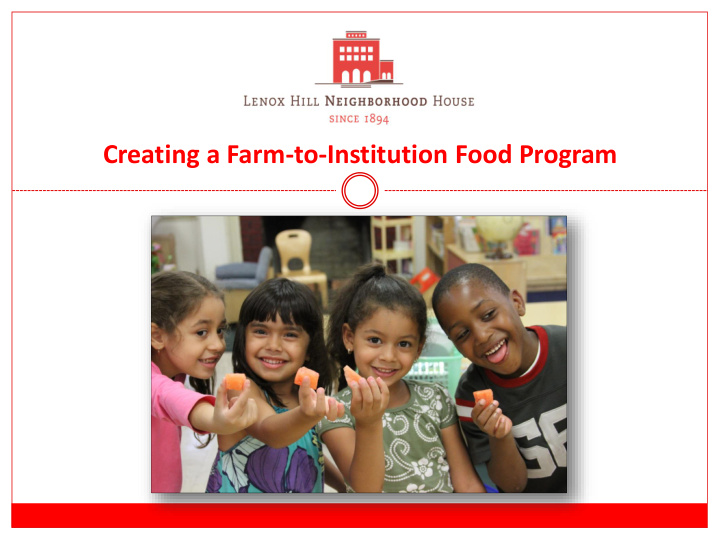



Creating a Farm-to-Institution Food Program
Lenox Hill Neighborhood House Lenox Hill Neighborhood House is a 121-year- old settlement house widely recognized as one of New York’s premier human services providers. Founded in 1894 as a kindergarten for immigrant children, the Neighborhood House now serves 20,000 individuals and families in need each year through a wide array of effective and integrated services — social, educational, legal, housing, health, mental health, nutritional and fitness. We have been feeding clients since 1894 and now provide more than 400,000 farm-to-table meals a year in our two senior centers, Head Start program, Women’s Mental Health Shelter, after school program, summer camp and more. For more information please visit our website at www.lenoxhill.org.
Farm-to-Institution: Background In 2011, Lenox Hill Neighborhood House hired its first Executive Chef. The new Executive Chef was given a mandate to: Make meals healthier Serve more fresh food Serve more local food
Farm-to-Institution: Four Years Later Lenox Hill Neighborhood House prepares and serves 400,000 healthy and delicious meals each year Almost everything made from scratch More plant-based meals More than 90% fresh food (about 40% local) Regional grains More sustainable: composting, no disposables CSA Food Box Program Expanded Health and Wellness programming Culinary Internship Program for clients Green Roof and Garden Always looking for what more we can do
Farm-to-Institution: Recipe for Success Assess all aspects of your program 1. Set attainable short-term goals 2. Implement change slowly 3. Engage staff and clients 4. Repeat! 5.
Assessment: Menus and Recipes Organized and reviewed all recipes and menus in current use for all programs Examined size of protein portions Looked at the processing level at which vegetables are purchased Identified most commonly used processed foods
Assessment: Vendors and Ingredients Examined current roster of vendors Made master lists of all ingredients currently ordered Outreach to vendors to determine: Full range of ingredients available from each Ability to provide local ingredients Ability to provide minimally-processed ingredients Determined our ability to add or change vendors Assessed cost of each segment ( dairy, meat, produce, etc. )
Assessment: Facilities Storage Dry Refrigerated Frozen Raw and prepped product Heavy equipment Smallwares Workspace Sanitation
Assessment: Staff Job descriptions of current workers Staff available for each shift Experience level Skills Culinary Knife Recipe reading and execution
Set Attainable Short Term Goals Menus and Recipes Vendors and Ingredients Facilities Staff
Implement Change: Menus and Recipes Replaced frozen and processed foods o We now use more than 90% fresh fruits and vegetables Reduced meat/protein portion size Added vegetarian entrees Integrated more whole grains Making from scratch All dressings and condiments ( also lowers costs ) Baked goods such as muffins, cornbread and healthy cookies Making our own mozzarella for pizza
Implement Change: Vendors and Ingredients Explored new vendors with healthier, less processed and local options Prompted existing vendors to provide improved options Partnered with GrowNYC local food hub o GrowNYC’s largest institutional customer o Using grains grown and milled in the region o Buying about 40% ( and growing ) regional produce Bid out selected segments (dairy, meat) for cost effectiveness and to enhance vendor performance Updated inventory systems to better track usage and cost
Implement Change: Facilities Storage Dry Refrigerated Frozen Raw and prepped product Heavy equipment Smallwares Workspace Sanitation
Implement Change: Staff Coordinated menus across programs for labor efficiency Expanded professional training and development Clarified and reformatted all recipes for ease of use in kitchen Utilized more interns from high schools, youth vocational programs, colleges and clients for labor and skill sharing
Engaging Staff Identify staff: Culinary interests and skills Culinary traditions Interests in cooking healthier food Individual and family health concerns In-service staff trainings (culinary and nutritional) Gardening with staff
Engaging Clients Nutritional Workshops Gardening Menu Meetings Food Surveys CSA Memberships Suggestion Box Blackboard/Information Sharing
Outreach Tabling at Health Fairs and Street Fairs Community Supported Agriculture ( GrowNYC Food Box Program ) Health and Wellness Classes ( Nutritional, Culinary, Gardening ) Children Older Adults Women living in our Homeless Shelter Internships Composting The Teaching Kitchen at Lenox Hill Neighborhood House Reinforce healthy eating across all programming
Expanding Impact • In November, we launched The Teaching Kitchen at Lenox Hill Neighborhood House. The goal of this training and technical assistance initiative is to help other nonprofit organizations serve more fresh, healthy and local food to improve their client’s health outcomes and ultimately to help shift New York City’s institutional food systems to more local sourcing to improve the region’s health, food security, economy and environment. • Over the coming year, the Neighborhood House intends to scale the program to train 250 organizations and 1,000 nonprofit staff annually.
Recommend
More recommend